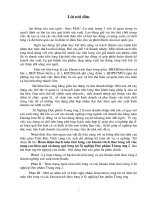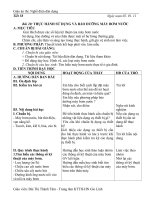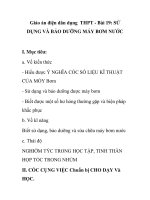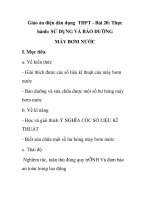Shop manual máy khoan hầm Boomer H282 - P4
Bạn đang xem bản rút gọn của tài liệu. Xem và tải ngay bản đầy đủ của tài liệu tại đây (1.6 MB, 36 trang )
PM No. 9852 1466 01c
2007-04
Atlas Copco
Boomer 281/282 with carrier DC15
Safety
Atlas Copco Rock Drills AB
SE-70191 Örebro, Sweden
SAFETY INSTRUCTIONS
Before starting, read all instructions carefully.
Special attention must be paid
to information alongside
this symbol.
Only use genuine Atlas Copco parts.
1250 0071 04
© Copyright 2007, Atlas Copco Rock Drills AB, Sweden
Any unauthorized use or copying of the contents or any part thereof is prohibited.
This applies in particular to trademarks, model denominations, part numbers and drawings.
Safety
3
Safety
1. Foreword .................................................................................................................. 5
Rig documentation................................................................................................... 5
The Manual.............................................................................................................. 5
2. Contents.................................................................................................................... 6
Contents, target group and objective....................................................................... 6
3. Safety regulations..................................................................................................... 7
General safety regulations ....................................................................................... 7
Guarantee................................................................................................................. 8
Warnings.................................................................................................................. 8
Description.......................................................................................................... 8
Heading............................................................................................................... 8
4. Risk area of the rig ................................................................................................. 10
Description ............................................................................................................ 10
Risk area ................................................................................................................ 10
Repositioning.................................................................................................... 10
Supported rig .................................................................................................... 10
Working in the risk area of the rig......................................................................... 11
Description........................................................................................................ 11
Specific expertise.............................................................................................. 11
Steps to take ...................................................................................................... 12
Special procedures ............................................................................................ 12
5. Warning signals...................................................................................................... 13
Acoustic warning................................................................................................... 13
Horn .................................................................................................................. 13
Reversing warning ............................................................................................ 13
Visual warning....................................................................................................... 13
Beacon .............................................................................................................. 13
6. Emergency stop...................................................................................................... 15
Function................................................................................................................. 15
Emergency stop location ....................................................................................... 15
Operator's station .............................................................................................. 15
Resetting emergency stop...................................................................................... 15
7. Fire-fighting ........................................................................................................... 16
Fire fighting equipment ......................................................................................... 16
Fire extinguishers .................................................................................................. 16
Description........................................................................................................ 16
Location of fire extinguisher ............................................................................ 17
Fire fighting systems ............................................................................................. 17
Ansul and Forrex .............................................................................................. 17
Safety
4
Principal components........................................................................................ 17
Location of Ansul equipment ........................................................................... 18
In case of fire ......................................................................................................... 18
Fire extinguishers.............................................................................................. 18
Hand-held fire extinguisher and fire fighting system. ...................................... 19
8. Signs....................................................................................................................... 21
General................................................................................................................... 21
Prohibition signs.................................................................................................... 21
Warning signs ........................................................................................................ 21
General warning signs ...................................................................................... 21
Service work ..................................................................................................... 22
Stability ............................................................................................................. 22
Tipping risk....................................................................................................... 23
Electrical system ............................................................................................... 23
Cable reeling unit.............................................................................................. 24
Service platform................................................................................................ 24
Climate unit....................................................................................................... 25
Laser.................................................................................................................. 25
Automatic.......................................................................................................... 26
Regulatory signs .................................................................................................... 27
General regulatory signs ................................................................................... 27
Alternating current generator............................................................................ 29
Rig with PLC cabinet........................................................................................ 29
Information signs................................................................................................... 30
Other signs............................................................................................................. 31
9. Rig stability ............................................................................................................ 32
Maximum permissible inclination angles.............................................................. 32
Rig stability requirements...................................................................................... 32
Atlas Copco requirements................................................................................. 32
Requirements in accordance with EN791:1996................................................ 33
Stability norm ........................................................................................................ 33
Description........................................................................................................ 33
Rig on wheels with booms/drilling unit in transport position .......................... 33
Rig on jacks with booms/drilling unit in working position. ............................. 34
10. Declaration ........................................................................................................... 36
EC - Declaration of conformity............................................................................. 36
Individual machine and safety components...................................................... 36
Other applicable directives ............................................................................... 36
Harmonised standards which have been applied .............................................. 36
Issuer................................................................................................................. 36
Safety
1. Foreword
5
1. Foreword
Rig documentation
The complete rig documentation comprises:
• a manual for the rig
• instructions for different components
• a spare parts catalogue for the rig
• spare parts lists for different components
• diagrams
The Manual
This manual is intended for the Boomer/Rocket Boomer 280 with DC15 and DC16
carrier.
The complete manual covers:
• Safety instructions
• Operator's instructions
• Maintenance instructions
• Maintenance intervals
• The manual is part of the complete delivery of a drill rig and its peripheral equip-
ment
• The manual does not replace the necessary training for the drill rig or its periph-
eral equipment.
Safety
2. Contents
6
2. Contents
Contents, target group and objective
The Safety section contains safety-related information intended to be used by every-
one operating the rig and its peripheral equipment.
The objective of the safety chapter is to prevent accidents by providing information
on the safety aspects concerning the rig and its peripheral equipment.
Safety
3. Safety regulations
7
3. Safety regulations
General safety regulations
• Read and comprehend the manual before the rig and its equipment is operated.
• The rig must only be used for the purposes described in these instructions, see
operator's instructions, Applications.
• Special attention must be paid to safety and all the warnings in the manual.
• It is essential that personnel observe general and local safety, health and traffic
regulations.
• Always use a helmet, hearing protection, protective safety glasses, safety gloves
and other necessary safety equipment when you are in the vicinity of the rig.
• Pay attention to the rig's warning signals when you are in the vicinity of the rig,
see Safety, Warning signals .
• The drilling equipment must only be used, maintained and repaired by personnel
well conversant with the equipment and the dangers involved.
• Checks and adjustments that are necessary when the rig is in operation must be
carried out by at least two persons. One person must then be present at the operat-
ing station and have a good view of the work.
• Extra caution must be exercised when changing a drill bit or drill steel see opera-
tor's instructions, Drilling.
• All work on tyres and rims may only be carried out by a qualified maintenance
technician.
• Before the rig is operated ensure that no one is in the rig's risk area, that the rig has
been maintained in accordance with the maintenance schedule in force, that all
controls, emergency stop and fire extinguishers are working satisfactorily, that
warning signs and safety labels are in the correct locations, are clean and fully leg-
ible. Report damage and deficiencies immediately. Do not operate the system
before all faults have been rectified. See also operator's instructions, Daily
inspection.
• Make sure brakes are applied and wheels blocked, or that the rig is on its jacks,
when parking and at the end of every shift. Inspect the emergency stop and safety
equipment as well.
• All work performed with the rig involves impact on the surrounding environment,
e.g. in the form of vibrations and landslide. Work must always be carried out with
great caution and in accordance with safety directives in force.
• Engine exhaust fumes are poisonous. Good ventilation is essential when the diesel
engine is running.
• During service work, stay only within areas indicated on the rig's engine cover. Do
not step onto opened service covers.
• When maintenance work is carried out under a raised cab, the cab must be secured
in the raised position.
Safety
3. Safety regulations
8
• When performing maintenance and renovation work on the rock drill, always fit
the rock drill on a folding plate. See Rock drill, Tool list.
• Ensure that there is no pressure in the hydraulic, pneumatic and water systems and
that the electrical system is turned off before removing the rock drill from the rig.
• Use approved lifting devices when handling the rock drill. Avoid lifting heavy
weights by hand.
Guarantee
• Use only Atlas Copco original parts. Any damage or operational interruptions
caused by using spare parts of other manufacture than Atlas Copco will not be
covered by warranty or product liability.
• Atlas Copco renounces any responsibility for damage caused by unauthorised
modification to the rig and its equipment.
• Overloading the rig can result in damage to machinery which is not noticed during
normal usage. Such damage is not covered by the guarantee.
• The manufacturer is not liable for damage caused by inappropriate use.
• Damage that occurs as a result of substandard repairs, as well as injury to person-
nel or damage to equipment that is attributable to older unrepaired damage, is not
covered by the guarantee.
Warnings
Description
The manuals contain warnings. The warnings are framed and contain a safety text
preceded by a warning symbol and a heading (danger, warning and caution).
Figure: Warning symbol
Heading
• The Danger heading indicates an imminent risk of serious or lethal injury if the
warning is not heeded.
• The Warning heading indicates a risk or dangerous course of action that can lead
to serious or lethal injury if the warning is not heeded.
Safety
3. Safety regulations
9
• The Caution heading indicates a risk or dangerous course of action that can lead to
personal injury or damage to property if the warning is not heeded.
Safety
4. Risk area of the rig
10
4. Risk area of the rig
Description
The risk area of the rig is a zone within or around the rig where a person is exposed to
risk of injury and health hazards.
The following points must be observed for the risk area of the factory delivered rig to
apply:
• good ventilation must be provided while the diesel engine is running.
• hearing protection, protective safety glasses and helmet must be used in the vicin-
ity of the rig when the rig is operating.
Risk area
Repositioning
Observe the following when moving the rig:
• Make sure that no one is in the rig's direction of travel.
• Make sure that no one remains in the rig's risk area.
Figure: Risk area during moving
Supported rig
When working in the risk area of a supported rig, see section Working in the risk
area of the rig.
2m
2m
2m
2m
1250 0160 00
Safety
4. Risk area of the rig
11
Figure: Risk area for supported rig
Working in the risk area of the rig
Description
Fault finding or working in the rig's risk area involves risk. Accordingly, always
carry out the fault finding or the work with great care and accuracy. For further safety
regulations, see Safety, Safety regulations.
Note
Pay attention to the rig's warning signals when you are in the vicinity of the rig, see
Safety, Warning signals.
Specific expertise
Specific expertise is required for:
• the electrical system
- Diagnosis of and work on the electrical system must only be performed by
appropriately authorised electricians.
• tyres and wheels
- All work on tyres and wheels must be carried out by specially trained mainte-
nance personnel as it is important to ensure that correct procedures are fol-
lowed and that the right tools are used.
• climate unit refrigerant system
1250 0130 25
17 m
28 m
Safety
4. Risk area of the rig
12
- Diagnosis of and work on the climate unit refrigerant system must only be per-
formed of specially trained maintenance personnel.
Steps to take
All work in the rig's risk area requires certain precautions:
• The electric motors and diesel engine must be switched off during fault finding
and work within the rig's risk area. For exceptions see section Special procedures.
• Hydraulic, pneumatic and water systems must be depressurised with diagnosis and
work in the rig's risk area. For exceptions, see section, Special procedures.
• The rig's electric power supply must be disconnected and locked during fault find-
ing and work within the rig's risk area (plug unplugged and socket locked with a
padlock). For exceptions, see section Special procedures.
• When diagnosis or work in the rig's risk area is to be performed, all components
which can be moved or continue moving must be secured, by supports or strap-
ping before the diagnosis or work is started.
Special procedures
Exercise extra caution and accuracy when fault finding diagnosis or other work is to
be performed at the same time as when one or more of the following points are appli-
cable:
• the electric motors are started
• the diesel engine is started
• the hydraulic pumps are running
• the rig's power supply is connected (plug is connected)
• the hydraulic system is pressurised
• the pneumatic system is pressurised
• the water system is pressurised
If one or more of the above criteria must be fulfilled in order to carry out fault finding
or certain work then special steps must be taken:
• The work must be carried out by at least two people, one of which must be at the
operating station and have a good view of the work.
Safety
5. Warning signals
13
5. Warning signals
Acoustic warning
Horn
The rig is equipped with a horn (1) located on the control panel.
Figure: Horn (1)
Reversing warning
The rig can be equipped with a reversing alarm (option) which sounds loudly when
reverse gear is engaged. This is to warn individuals in the vicinity that the rig is
reversing.
Visual warning
Beacon
The rig is equipped with a warning beacon (option) that lights up when the ignition
has been turned on. This is to attract the attention of anyone in the vicinity that the rig
is about to be moved.
1
1250 0100 24
Safety
5. Warning signals
14
Figure: Warning beacon
1250 0130 76









